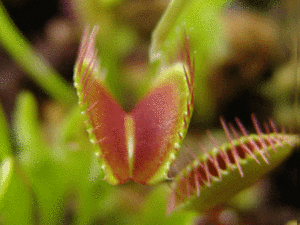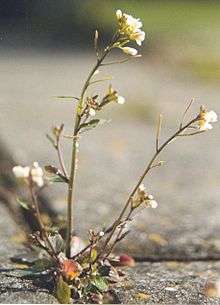Plant arithmetic
Plant arithmetic is a form of plant cognition whereby plants appear to perform arithmetic operations – a form of number sense in plants.
Arithmetic by species
Venus flytrap

The Venus flytrap can count to two and five in order to trap and then digest its prey.[1]
The Venus flytrap is a carnivorous plant that catches its prey with a trapping structure formed by the terminal portion of each of the plant's leaves, which is triggered by tiny hairs on their inner surfaces. When an insect or spider crawling along the leaves contacts a hair, the trap prepares to close, snapping shut only if a second contact occurs within approximately twenty seconds of the first strike. The requirement of redundant triggering in this mechanism serves as a safeguard against wasting energy by trapping objects with no nutritional value, and the plant will only begin digestion after five more stimuli to ensure it has caught a live bug worthy of consumption.
The mechanism is so highly specialized that it can distinguish between living prey and non-prey stimuli, such as falling raindrops;[2] two trigger hairs must be touched in succession within 20 seconds of each other or one hair touched twice in rapid succession,[2] whereupon the lobes of the trap will snap shut, typically in about one-tenth of a second.[3]
Arabidopsis thaliana
Arabidopsis thaliana performs division to control starch use at night.[4]
Most plants accumulate starch by day, then metabolize it at a fixed rate during night time. However, if the onset of darkness is unusually early, Arabidopsis thaliana reduces its use of starch by an amount that effectively requires division.[5] However, there are alternative explanations,[6] such as feedback control by sensing the amount of soluble sugars left is possible,[7] but as of 2015, open questions remain.[8]
See also
References
- Böhm, Jennifer; Scherzer, Sönke; Krol, Elzbieta; Kreuzer, Ines; von Meyer, Katharina; Lorey, Christian; Mueller, Thomas D.; Shabala, Lana; Monte, Isabel; Solano, Roberto; Al-Rasheid, Khaled A.S.; Rennenberg, Heinz; Shabala, Sergey; Neher, Erwin; Hedrich, Rainer (February 2016). "The Venus Flytrap Dionaea muscipula Counts Prey-Induced Action Potentials to Induce Sodium Uptake". Current Biology. 26 (3): 286–295. doi:10.1016/j.cub.2015.11.057. PMC 4751343. PMID 26804557.
- Raven, Peter H.; Evert, Ray Franklin; Eichhorn, Susan E. (2005). Biology of Plants (7th ed.). W.H. Freeman and Company. ISBN 978-0-7167-1007-3.
- Forterre, Yoël; Skotheim, Jan M.; Dumais, Jacques; Mahadevan, L. (27 January 2005). "How the Venus flytrap snaps" (PDF). Nature. 433 (7024): 421–425. doi:10.1038/nature03185. PMID 15674293. Archived from the original (PDF) on 2 December 2007.
- Ledford, Heidi (24 June 2013). "Plants perform molecular maths". Nature. doi:10.1038/nature.2013.13251.
- Scialdone, Antonio; Mugford, Sam T; Feike, Doreen; Skeffington, Alastair; Borrill, Philippa; Graf, Alexander; Smith, Alison M; Howard, Martin (25 June 2013). "Arabidopsis plants perform arithmetic division to prevent starvation at night". eLife. 2: e00669. doi:10.7554/eLife.00669. PMC 3691572. PMID 23805380.
- Webb, A. A. R.; Satake, A. (5 March 2015). "Understanding Circadian Regulation of Carbohydrate Metabolism in Arabidopsis Using Mathematical Models". Plant and Cell Physiology. 56 (4): 586–593. doi:10.1093/pcp/pcv033. PMID 25745029.
- Feugier, François G.; Satake, Akiko (2013). "Dynamical feedback between circadian clock and sucrose availability explains adaptive response of starch metabolism to various photoperiods". Frontiers in Plant Science. 3: 305. doi:10.3389/fpls.2012.00305. PMC 3544190. PMID 23335931.
- Scialdone, Antonio; Howard, Martin (31 March 2015). "How plants manage food reserves at night: quantitative models and open questions". Frontiers in Plant Science. 6: 204. doi:10.3389/fpls.2015.00204. PMC 4379750. PMID 25873925.
